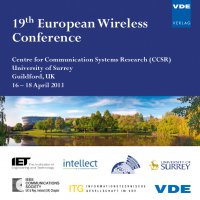Effective Service Capacity Analysis of Interference-Limited Multi-Carrier Wireless Systems
Conference: European Wireless 2013 - 19th European Wireless Conference
04/16/2013 - 04/18/2013 at Guildford, UK
Proceedings: European Wireless 2013
Pages: 7Language: englishTyp: PDF
Personal VDE Members are entitled to a 10% discount on this title
Authors:
Weyres, Marco (UMIC Research Centre, RWTH Aachen University, Germany)
Gross, James (School of Electrical Engineering, Royal Institute of Technology, Sweden)
Abstract:
A good utilization of a wireless network while still ensuring QoS-constraints for all users is a hard challenge for service providers. Especially for admission control or handover decisions it is important to have a good approximation of the possible rate a user can achieve with respect to QoS parameters like delay or outage probabilities. Since fourth generation cellular networks utilize a frequency reuse of one, especially terminals at the cell edge suffer from inter-cell interference. In order to provide them with rates that guarantee specific QoS parameters without reserving too much resources, a good prediction of their possible rates is needed. Unfortunately, the prediction of the rates in an interference-limited cell is a complex and hard problem. Hence, it is a common way to simplify calculations by treating interference as additional noise in the used system models. In this paper we derive closed-form solutions for the delay distribution of interference-limited cells with respect to an OFDMA and a round robin scheduling approach. These distributions can be used to predict the possible rates of users given their average received transmitter gains, interferer gains and their QoS-constraints in a very accurate way. We validate our derivations and show that a simplification by treating interference as noise leads to an underestimation of rates which lowers the cell throughput. Furthermore, we show that due to the resulting equations, there is no way to derive the rates for interference limited cells in a linear way from easier solutions given by noise-limited cells.


